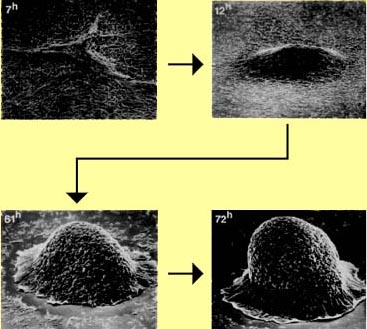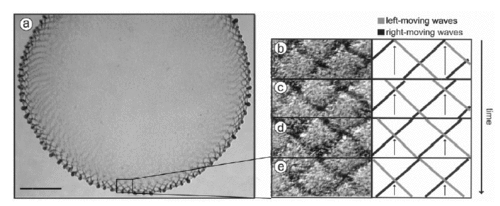Myxococcus
A Microbial Biorealm page on the genus Myxococcus

Classification
Higher order taxa:
Bacteria; Proteobacteria; delta/epsilon subdivisions; Deltaproteobacteria; Myxococcales; Cystobacterineae; Myxococcaceae
Species:
Myxococcus coralloides, M. flavescens, M. fulvus, M. macrosporus, M. stipitatus, M. virescens, M. xanthus
Genome Structure
Myxobacterial genomes are between 9 and 10 Mbp long, larger than any free-living bacteria without a developmental cycle. They have a G+C content of between 67 and 71%. Myxococcus has a developmental cycle in which it forms multicellular fruiting bodies that contain spores. To date, no Myxobacteria genomes have been sequenced, although the genome of Myxococcus xanthus has been mapped, and measures 9.2 Mbp long with a G+C content of 67.5%.
Cell Structure and Metabolism
Myxococci are Gram-negative, spore-forming, chemoorganotrophic, obligate aerobes. They are elongated rods with rounded or tapered ends, and they are nonflagellated.
Ecology
Myxobacteria most commonly inhabit topsoil, mainly in the pH range from 5 to 8, although they can also be found at extreme pHs. They like soil rich in organic matter best, but also occur in sand and on rocky surfaces. They also inhabit decaying plant material, and are represented in fresh water. It has been shown that fruiting body formation is both possible and effective in submerged Myxobacteria. Overall, it is a rather versatile genus. Myxobacteria, due to their gliding method of motility, form colonies on agar that spread fil-like over the entire plate, after about three days, and often exhibit concentric rings.
Gliding motility, as mentioned above, is important when Myxobacteria reconvene during times of nutrient depletion in order to form fruiting bodies which consist of about 104 to 106 cells. As cells divide and multiply they move away from each other (somewhat) secreting a polysaccharide slime, which they use to retrace their steps when nutrients become scarce. They migrate back along the slime, aggregating by chemotaxis, to form fruiting bodies, which are raised above the agar surface in order to disseminate the spherical myxospores being formed by the vegetative Myxobacterial cells as they migrate upward in the fruiting body.
In addition to aggregating to form fruiting bodies, which in and of itsself, is an unusually social behavior for bacteria to exhibit, some cells also commit 'suicide' to ensure the survival of other cells. During the process of fruiting body formation only a minority of cells that aggregate form spores. Many cells, instead, lyse, releasing their contents which serve to feed the sporulating cells.
An interesting phenomenon that rises out of the aggregation of Myxobacterial cells during times of nutrient depletion, is the pattern in which they migrate. It has been observed that Myxobacteria migrate, in the early stages of starvation-induced fruiting body development, in a "highly organized periodic pattern of equispacedaccumulations that move as traveling waves" (Welch & Kaiser). There are two sets of waves, called ripples, moving in opposite directions, with the same wavelength and speed.
While aggreagation for the formation of fruiting bodies during times of starvation is their most dramatic social behavior, myxobacteria exhibit other social behaviors. They move and feed in a cooperative tight group, which brings to mind a wolf-pack. They move through the soil (their natural habitat) secreting enzymes that will lyse their prey, exhibiting social predation common to much more complex organisms.
Isolation and Cultivation
Myxobacteria can be cultivated on a liquid medium containing a nitrogen source. Look up some experiments and figure it out. Get out there and have fun! Click here for an example of one recent study about finding a novel type of geosmin biosynthesis in myxobacteria.
References
He, Qian et al. 1994. A physical map of the Myxococcus xanthus chromosome. PNAS, 91: 9584-9587.
Strassman, Joan E. 2000. Bacterial cheaters. Nature, 404: 555-556.

